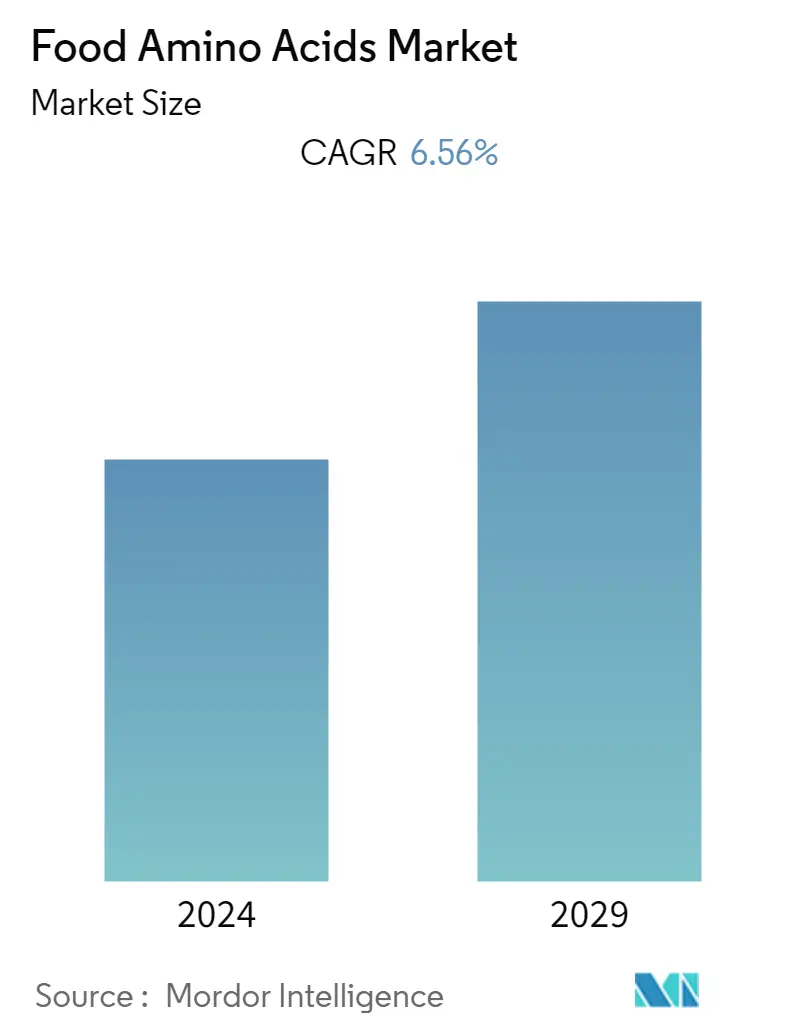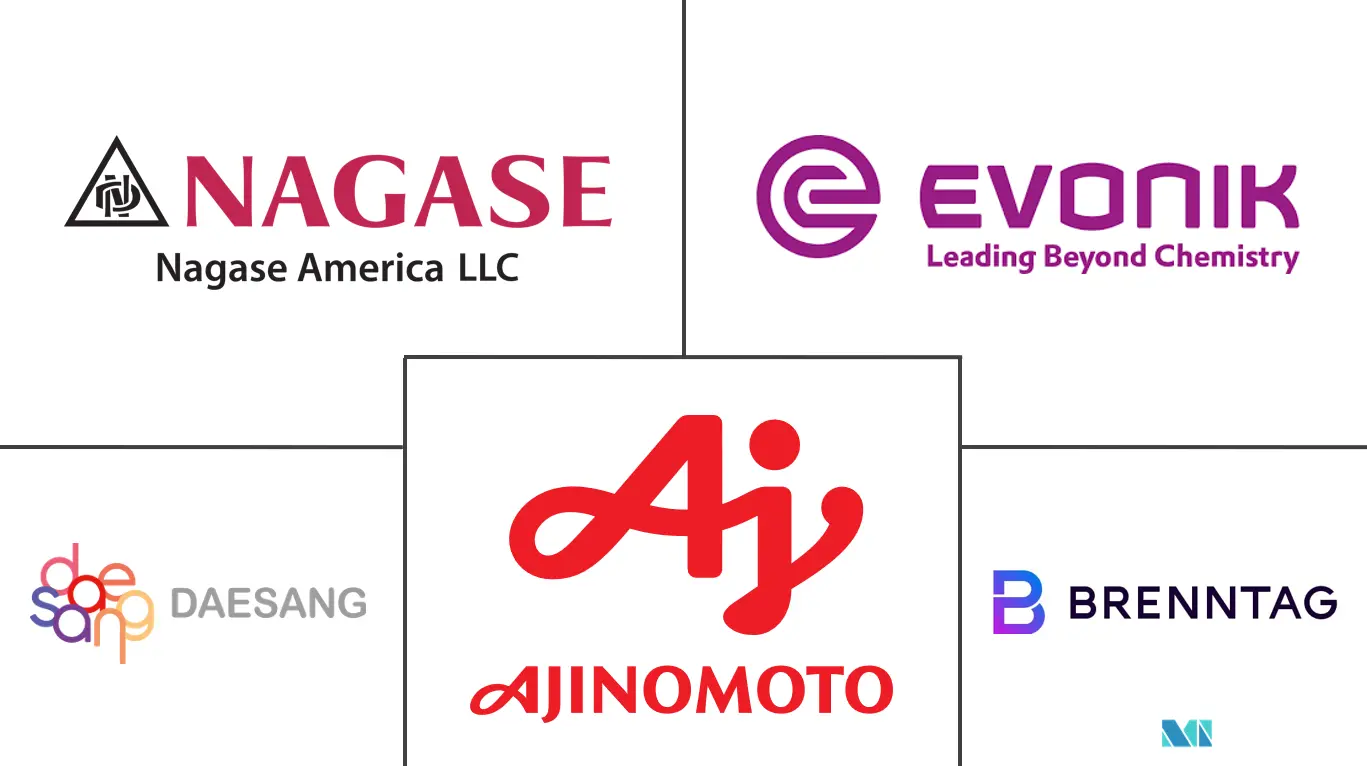Market Size of Food Amino Acids Industry

| Study Period | 2019 - 2029 |
| Base Year For Estimation | 2023 |
| CAGR | 6.56 % |
| Fastest Growing Market | North America |
| Largest Market | Asia-Pacific |
| Market Concentration | Low |
Major Players
*Disclaimer: Major Players sorted in no particular order |
Food Amino Acids Market Analysis
The Food Amino Acid Market is projected to register a CAGR of 6.56% during the forecast period.
The increasing demand for amino acids as functional foods, coupled with the rising adoption of glutamic acid as a flavor enhancer in various foods and beverages, is likely to propel the market's growth over the next few years. The wide range of applications of amino acids, ranging from flavor development and preservation to acting as a nutritional component or building block of protein to specialty ingredients, such as aspartame, is expected to drive the market.
Additionally, the increase in demand for amino acids for various nutraceutical and dietary supplements, owing to the health benefits offered by amino acids, is expected to fuel the demand for amino acids during the forecast period. The use of lysine in dietary supplements is expected to boost the market's growth as well. The increasing demand for amino acids particularly, L-lysine and glutamic acid have triggered the fact that meeting the production demand with cost-effective raw material and recovery process is likely to be challenging in the upcoming years. The requirement of specific substrates in the enzymatic method limits the competitiveness of the method, as it is primarily dependent on the cost of manufacturing the substrate. Individual protein requirements, completeness/ amino acid profiles, the importance of other protein components, and new sources for protein consumption remain some of the prominent factors that companies are working on to target untapped markets. With several research & development activities, amino acids have been found to have multiple functional benefits in human nutrition. For example, glycine has been found to improve sleep quality; and leucine for its role in muscle protein synthesis, thus contributing to longer healthy life expectancy in the elderly population.
Additionally, in 2021, Ulrick & Short, a manufacturer of ingredients, added a new protein to its lineup to enable foods to have comprehensive amino acid profiles in addition to fortification. The increase in the international sporting event has also led to increased attention on the physiological effects of amino acids (BCAAs) on muscles- which is likely to offer a potential opportunity to amino acid ingredient manufacturers. There are products in the market, based on the physiological effects of amino acids, and are targeting as well as positioning their product of both recreational and professional athletes.
Food Amino Acids Industry Segmentation
Amino acids together constitute the molecules that form protein. Food amino acids are ingredients that are used in the preparation of different protein-rich products across different industries. The global food amino acids market is segmented by type, application, and geography. Based on type, the market is segmented into glutamic acid, lysine, tryptophan, methionine, phenylalanine, and other types. Based on application, the market is further segmented into dietary supplements, fortified food and beverage, and infant nutrition. Moreover, the study provides an analysis of the food amino acids market in emerging and established markets across the globe, including in North America, Europe, Asia-Pacific, South America, and Middle-East and Africa. For each segment, the market sizing and forecasts have been done on the basis of value (in USD million).
| Type | |
| Glutamic Acid | |
| Lysine | |
| Tryptophan | |
| Methionine | |
| Phenylalanine | |
| Other Types |
| Application | |
| Dietary Supplements | |
| Fortified Food and Beverage | |
| Infant Nutrition |
| Geography | |||||||||
| |||||||||
| |||||||||
| |||||||||
| |||||||||
|
Food Amino Acids Market Size Summary
The food amino acids market is experiencing significant growth, driven by the increasing demand for amino acids as functional foods and their rising adoption as flavor enhancers in various food and beverage applications. The versatility of amino acids, serving as nutritional components, protein building blocks, and specialty ingredients, is a key factor propelling market expansion. The growing interest in nutraceuticals and dietary supplements, particularly those containing lysine and glutamic acid, is further fueling demand. However, challenges such as the need for cost-effective raw materials and recovery processes, along with the specificity required in enzymatic methods, pose potential hurdles. Companies are focusing on addressing individual protein requirements and exploring new protein sources to tap into untapped markets. Research and development activities continue to uncover the functional benefits of amino acids in human nutrition, enhancing their appeal in various sectors.
The Asia-Pacific region holds the largest market share, driven by the increasing use of amino acids as flavor enhancers and a growing consumer focus on healthy diets. The demand for food amino acids in dietary supplements is also rising, with countries like China and Indonesia leading imports. The market is characterized by fragmentation, with numerous international and local players competing for market share. Key companies are leveraging product innovation and geographic expansion to gain a competitive edge. The introduction of new products, such as aminoVITAL by Ajinomoto, highlights the trend towards using amino acids to enhance athletic performance and recovery. The market's growth is supported by the rising popularity of sports nutrition products and the increasing incorporation of protein supplements into regular diets, particularly in regions like Australia.
Food Amino Acids Market Size - Table of Contents
-
1. MARKET DYNAMICS
-
1.1 Market Drivers
-
1.2 Market Restraints
-
1.3 Porter's Five Forces Analysis
-
1.3.1 Threat of New Entrants
-
1.3.2 Bargaining Power of Buyers/Consumers
-
1.3.3 Bargaining Power of Suppliers
-
1.3.4 Threat of Substitute Products
-
1.3.5 Intensity of Competitive Rivalry
-
-
-
2. MARKET SEGMENTATION
-
2.1 Type
-
2.1.1 Glutamic Acid
-
2.1.2 Lysine
-
2.1.3 Tryptophan
-
2.1.4 Methionine
-
2.1.5 Phenylalanine
-
2.1.6 Other Types
-
-
2.2 Application
-
2.2.1 Dietary Supplements
-
2.2.2 Fortified Food and Beverage
-
2.2.3 Infant Nutrition
-
-
2.3 Geography
-
2.3.1 North America
-
2.3.1.1 United States
-
2.3.1.2 Canada
-
2.3.1.3 Mexico
-
2.3.1.4 Rest of North America
-
-
2.3.2 Europe
-
2.3.2.1 United Kingdom
-
2.3.2.2 Germany
-
2.3.2.3 France
-
2.3.2.4 Russia
-
2.3.2.5 Italy
-
2.3.2.6 Spain
-
2.3.2.7 Rest of Europe
-
-
2.3.3 Asia-Pacific
-
2.3.3.1 India
-
2.3.3.2 China
-
2.3.3.3 Japan
-
2.3.3.4 Australia
-
2.3.3.5 Rest of Asia-Pacific
-
-
2.3.4 South America
-
2.3.4.1 Brazil
-
2.3.4.2 Argentina
-
2.3.4.3 Rest of South America
-
-
2.3.5 Middle-East and Africa
-
2.3.5.1 Saudi Arabia
-
2.3.5.2 South Africa
-
2.3.5.3 Rest of Middle-East and Africa
-
-
-
Food Amino Acids Market Size FAQs
What is the current Food Amino Acids Market size?
The Food Amino Acids Market is projected to register a CAGR of 6.56% during the forecast period (2024-2029)
Who are the key players in Food Amino Acids Market?
Nagase America LLC, Ajinomoto Co., Inc., Evonik Industries AG, Daesang Corporation and Brenntag AG are the major companies operating in the Food Amino Acids Market.

